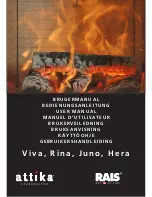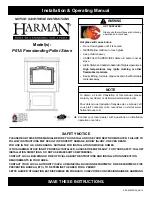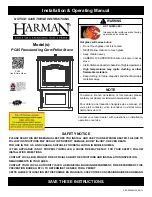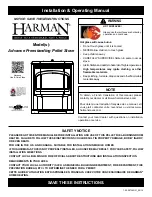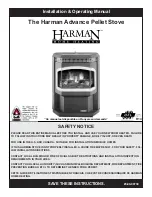
The term Multi-fuel refers to any of the main commercially available solid fuels such as coal,
wood, turf, anthracite, briquettes. Never use liquid fuels such as oil or kerosene when
lighting or refreshing the fire or at any other time. Do not store liquid fuels near stove.
The burning of solid fuels gives off gases which can be extremely dangerous. These gases
under normal operating conditions will pass up the flue/chimney, and not to escape into your
home, however it is important that your flue system is properly installed and that you check
all joints regularly to ensure there are no cracks or gaps. Also check the door sealing rope
and replace when worn or damaged. We recommend a smoke alarm be fitted in the room
where stoves are installed.
Do not use stove in a room where negative pressure conditions may occur, such as through
the use of extraction fans unless adequate air supply into the room is ensured, as this may
draw air through the stove, thereby escaping into the room.
Creosote and soot may accumulate in your flue pipe and chimney; this may ignite to
cause a chimney fire. If you suspect a chimney fire, evacuate people from the building,
shut down the air controls on the stove and call the Fire Department. To prevent the
accumulation of soot or creosote, check flue and chimney regularly and clean as necessary.
In general well burning hot stoves will cause a lot less build-up than slow burning stoves;
likewise dry wood will cause less build-up than wet wood. We recommend a fire extingu-
isher be available where stoves are in operation. In the event of a chimney fire do not
re-light the stove until the stove and flue/chimney system has been thoroughly cleaned,
checked and repaired as necessary.
Stoves get extremely hot and should not be touched, where young children are in the area
we recommend the use of a suitable fire guard around the stove. Always wear protective
Never use a fan to supply air to the stove or to extract from it.
All users of the stove should be aware of the contents of this manual. Please leave this
manual where it is accessible to stove users and do not allow anyone to use the stove
who is unfamiliar with its correct operation.
Never use the stove if any parts are missing or damaged, only use
genuine parts as replacements and Never modify your stove.
Stove Safety
gloves when reloading stove.
Never over fire your stove, if external parts of your stove are glowing red then the stove is
over firing and your draught settings should be reduced. Never interfere with the draught
mechanisms or adjust your air settings outside those limits set when the stove is
manufactured.
Before installing your stove
You need to consider the following to ensure the safe operation of your stove.
Provision of adequate air to support efficient combustion of the fuel.
A well sealed flue/chimney system, herein after referred to as the flue system .
The protection of combustible materials in proximity of the stove.
3
4
When properly maintained and operated your stove will give you many years of service; however
there are important safety aspects of these products that you need to be aware of when operating
a multi-fuel stove.
We hope you have many years of comfor t and warmth from your
stove, but please do so safely.
Adequate provision air
It is essential for the safe and efficient use of your stove that you provide an adequate airsupply to
Your stove. This may mean the provision of an outside air supply to the room, especially if there are
extraction units such as cooker hoods or clothes dryers in the vicinity. Failure to do so will mean
that fuel is burned inefficiently causing smoke and blackening the glass and may also cause smoke
to come back into the room. It is normal for the stove to emit smoke and the glass to blacken when









